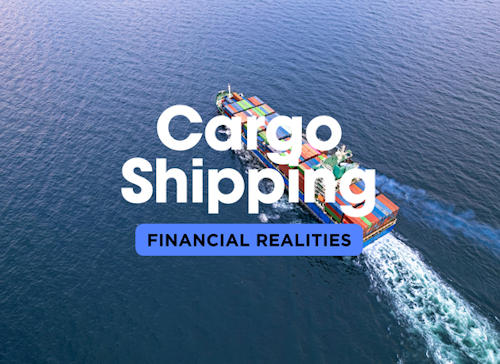
Entering the cargo shipping industry involves significant financial investments and ongoing expenses. Understanding these costs is essential for making informed decisions. Below, we outline the top 10 highest expenses, starting with the initial investment and moving into ongoing operational costs.
1. Purchase Price of the Ship
- New vs. Used Vessels:
- New cargo ships can cost between $50 million to over $150 million, depending on size, type, and specifications.
- Second-hand ships are generally cheaper, ranging from $10 million to $50 million, but may require more maintenance.
- Additional Costs:
- Customizations and upgrades to meet specific operational needs can add to the initial purchase cost.
- Considerations:
- The decision between new and used vessels involves balancing upfront costs with potential long-term savings in maintenance and fuel efficiency.
2. Financing and Insurance
- Loan Costs:
- Financing a cargo ship usually involves substantial loans, with interest rates influenced by the borrower’s creditworthiness and market conditions.
- Typical loan durations range from 10 to 20 years, with varying repayment schedules.
- Insurance Premiums:
- Comprehensive insurance covers risks like accidents, natural disasters, and piracy.
- Annual premiums can range from hundreds of thousands to several million dollars, depending on factors such as the ship’s size, route, cargo type, and the shipowner’s claims history.
- Additional Insurances:
- Maritime insurance offers coverage for specific risks, such as loss of hire (compensation for lost income during downtime), may also be required.
3. Crew Salaries and Training
- Salary Breakdown:
- Crew salaries vary widely, with captains and chief engineers earning significantly more than other crew members.
- Total crew costs can reach hundreds of thousands of dollars per month, depending on the size of the ship and the number of crew members.
- Training and Certifications:
- Continuous training is required to keep the crew updated on safety protocols, new technologies, and regulatory changes.
- Costs for training and certification can add significantly to the overall crew-related expenses.
- Retention and Recruitment:
- Attracting and retaining skilled crew members may require additional benefits and competitive compensation packages, especially in a market with a shortage of qualified personnel.
4. Fuel Costs
- Types of Fuel:
- Common fuels include heavy fuel oil (HFO), marine diesel oil (MDO), and more recently, low-sulfur fuel oil (LSFO) to comply with environmental regulations.
- Fuel Consumption:
- The amount of fuel consumed depends on the ship’s size, speed, and route. Larger vessels and higher speeds significantly increase fuel consumption.
- Fuel Price Volatility:
- Fuel prices are subject to global oil market fluctuations, which can impact operating costs unpredictably.
- Environmental Regulations:
- Compliance with regulations such as the International Maritime Organization’s (IMO) sulfur cap may require using more expensive, cleaner fuels or installing scrubbers, which are additional capital investments.
5. Maintenance and Repairs
- Routine Maintenance:
- Includes regular inspections, cleaning, and servicing of machinery and equipment to prevent breakdowns.
- Typical maintenance costs can include parts replacement and labor, often scheduled during port stops.
- Dry-Docking:
- A more extensive maintenance process where the ship is taken out of water for a thorough inspection and repairs, which is usually required every 2-5 years.
- Dry-docking involves significant costs, including port fees, labor, and materials, and can run into the millions of dollars.
- Unexpected Repairs:
- Unforeseen issues such as mechanical failures or damage from rough seas can lead to costly emergency repairs.
- Lifecycle Management:
- Ongoing maintenance is critical to prolonging the vessel’s lifespan and maintaining its resale value.
6. Port Fees and Handling Charges
- Docking Fees:
- Charges for docking at ports vary based on the port’s size, location, and facilities. High-traffic ports often have higher fees.
- Pilotage and Towage:
- Many ports require ships to use local pilots and tugboats for navigation and docking, which incurs additional costs.
- Cargo Handling:
- Charges for loading and unloading cargo, which can depend on the type and volume of cargo as well as the port’s efficiency and labor costs.
- Additional Fees:
- Other fees may include customs, port security, and waste disposal fees, all of which can add up depending on the port and country of operation.
7. Regulatory Compliance and Certifications
- International Regulations:
- Compliance with international maritime regulations, such as the International Safety Management (ISM) Code and the International Ship and Port Facility Security (ISPS) Code, is mandatory.
- Regular audits and inspections are required to maintain certifications, which can involve significant costs.
- Environmental Compliance:
- Meeting environmental standards, such as those set by the IMO, often requires investments in technology like ballast water treatment systems and emission reduction technologies.
- Certification Costs:
- Costs associated with obtaining and maintaining necessary certifications, such as safety equipment certifications, crew certifications, and vessel classification, can add up.
8. Cargo Insurance
- Coverage:
- Cargo insurance covers potential losses or damages to goods during transit, providing protection against risks such as theft, damage, or accidents.
- Cost Factors:
- Insurance premiums vary based on the type of cargo, route, and destination. High-value or high-risk cargo typically incurs higher premiums.
- Additional Coverage:
- Additional coverage options, such as political risk insurance or coverage for delays, may also be considered, depending on the nature of the cargo and route.
9. Technology and Communication Systems
- Navigation and Safety Equipment:
- Investing in advanced navigation systems, radar, and safety equipment is crucial for safe and efficient operations.
- Regular updates and maintenance of these systems are necessary to comply with regulations and ensure optimal performance.
- Communication Systems:
- Reliable communication systems, including satellite communication, are essential for maintaining contact with the crew, ports, and other stakeholders.
- IT Infrastructure:
- Cybersecurity and data management systems are becoming increasingly important in modern shipping, adding to the costs.
10. Operational and Administrative Costs
- Operational Costs:
- These include everyday expenses such as provisioning for the crew, fuel for auxiliary engines, and supplies for maintenance.
- Administrative Expenses:
- Administrative costs encompass management fees, legal services, accounting, and other office-related expenses.
- Shore Support:
- Expenses for shore-based support, including logistics coordination, port agents, and other third-party services, are crucial for smooth operations.
Entering the cargo shipping industry requires careful financial planning and a comprehensive understanding of the various costs involved. From the initial investment in the vessel to ongoing operational and regulatory expenses, each cost plays a critical role in determining the profitability and sustainability of the business. By being well-informed about these expenses, prospective shipowners can make strategic decisions that optimize their investment and ensure the long-term success of their venture in the cargo shipping industry.


